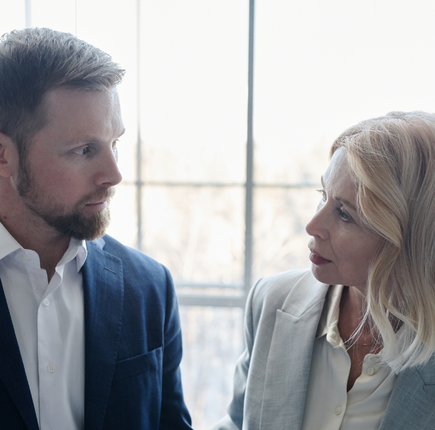The Language of Change
Curtis Bateman
10th November 2022
- 6 min read

“Language is the road map of a culture. It tells you where its people come from and where they are going.”- Rita Mae Brown
What happens when there’s a bump in that road? Or a storm felled tree blocking it?
When change, of any kind, makes direction or destination less certain, language has to work a lot harder to keep people calm, connected, and committed to a collective purpose.
The map it provides becomes riskier to navigate when the words we wield mean the difference between progress and chaos. Words have the power to motivate, inspire, and bring out the best in people; but they can also be misused, leading to stress, anxiety and resentment.
A leader’s dilemma
Our emotional reactions to language are largely unavoidable. That is why the words you use matter and intentional language is critical in guiding reactions to change. There are two dilemmas’ leaders face which makes this difficult.
Dilemma 1: Our personal susceptibility to uncertainty
In an organisational change, the leader is first a person. They’re experiencing the change as well, along with all the second-guessing and hand-wringing that brings. It can be difficult to separate the instinct to preserve what matters to you personally and the need to lead, the responsibility to represent stability. This internal conflict can make behaviour erratic, judgement less objective and communication more likely to confuse than clarify.
Dilemma 2: The employee experience bias
Humans are hardwired to dislike and resist change, often finding the idea of it threatening. This is because we learn from our past experiences, and chances are we’ve had many bad experiences surrounding change that have reinforced our physiological stress response to the idea of it.
In fact, global FranklinCovey research found that 88% of surveyed employees believed the change they were experiencing was going to make things worse for themselves, not better.
This individual perception of change is a lot to contend with when you are responsible for implementing or delivering on it, so the positioning is critical. The rise of hybrid and remote working has made this an even more delicate needle to thread as virtual tools have led to spiky topics being voiced in ways not formerly accepted and intent being more easily misinterpreted.
Leaders especially must tread carefully in these environments because our words hold extra weight for longer when seen in text. Their impact can be tough to shake off.
The FranklinCovey Change Model offers a kind of playbook, demystifying how you prepare for, initiate, lead, and navigate change. It provides a common language that empowers you to guide and maintain the conversation rather than have it move to the water cooler where you have less influence and impact.

Emotion has its place, but it can’t dictate
Let me be clear: Emotions aren’t bad, they are human. Even negative ones. They’re natural. They’re allowed. In fact, they’re encouraged; empathy and understanding are always essential. What the Change Model does is break the ever-predictable process of change down into zones that help to label the psychological and functional processes of each stage of change.
From the zone of status quo, through disruption, adoption, and innovation – each zone enables us to make sense of what’s happening, what we’re feeling and why. The zone of disruption- What’s changing? Why’s it changing? How will it affect me? – is a crucial time for leaders seeking to clarify, reassure and motivate. Leveraging the model helps you step out of the emotion yourself, make sense of the emotions of your team and use language that is factual rather than threatening.
Using overly emotive language simply creates a bad entry point into change. And I mean strongly emotive in either direction. Negativity fuels anxiety. But excessive positivity can appear disingenuous or feel invalidating and toxic. It can arouse suspicion and there we go again – anxiety. This is why the key to calm is emotional neutrality.
What happens when we are overly emotional as leaders?
When a leader is sporadic or overly optimistic/pessimistic in their delivery of a key message surrounding change, here’s what goes wrong within the team:
People feel lost and unimportant. They don’t know what’s expected of them. They don’t take initiative or make any decisions because they don’t feel led or directed enough to have the confidence to do so.
They fear asking questions or raising concerns. If they do, they suspect their valid offerings will be met with defensiveness and frustration or dismissed with platitudes rather than answers.
Negativity, insecurity, and unease pervade a stressful environment. Bad news for both morale and productivity. Emotional volatility is stressful to watch. As leaders we need to provide stability and guidance – human as we may be, it’s important to strive for consistency even during moments of crisis.
Make change a case of Moving From and Moving To
More than a way of communicating what’s happened or will happen, the Change Model gives us the tools to talk about what’s going on, where we are, where you need to be and actions that you can be taking.
‘Moving From’ and ‘Moving To’ is a simple shift in language which has a dramatic impact on both your own thinking and that of your team. Consider the power of getting clear on the below:
Moving from: “We used to be responsible for these results…”
To: “Now we must achieve these results…”
Moving from: “We used to take these actions…”
To: “Now we need to take these action…”
By adopting this language, leaders are empowered to address the two dilemmas I highlighted a few paragraphs ago. You are able to clarify situations, manage expectations and reactivate a sense of control. It’s an exercise which turns the change from something unknowable into something achievable.
More ways you can make the move from emotional to factual…
Move your focus from the past to the future.
Out – “We used to…”
In – “We will…”
Move from confrontation to cooperation.
Out – “Why did this happen?”
In – “What have we learned from this?”
Move from helplessness to assuredness.
Out – “I have to.”
In – “I will.”
Move from using negatives to denote positives.
Out – “Why not?”
In – “Let’s go for it.”
Move from accusation to reflection.
Out – “You’re being difficult, why are you getting upset?”
In – “We’re in the zone of disruption. Let’s talk about what we’re thinking, feeling and doing.”
Don’t underestimate the power of language
When used thoughtfully, effectively, and consistently, language has the power to transform the impact change has on both yourself and your team. This first requires recognising the fact we as leaders are not immune to uncertainty because of our title. Without intentionally building the capability to manage your own reaction to change, your biases and concerns will colour everything- your team’s responses, activities, perceptions, performance- before the change has even really taken hold. By mastering clear and compelling communication leaders can de-risk the process, leave less open to interpretation and create confidence- in both your leadership and the idea that success together is possible.
Be inspired to apply the Change Model to how you lead yourself and others through change with Curtis Bateman’s new book ‘Who Rocked the Boat? A Story About Navigating the Inevitability of Change’. Click here to learn more and get your copy now.





